ICAO english test level 4 -
how to pass with ease
THE ICAO english test level 4 needs to be taken every 4 years. English is the international language of aviation. Pilots and air traffic controllers around the world use English to communicate safely and clearly.
How does the aviation community guarantee this? It insists on having you take proficiency tests.
Read on and you will learn how to go from Level 3 (Pre-operational) to Level 4 (Operational) so that you can pass with ease every time.
If you can read and understand this page then you probably have a basic understanding of the English language.
Let's look at the parts of the ICAO English test level 4
Although the format can differ from one testing organization to another, most ICAO English tests include six main areas based on the ICAO Language Proficiency Rating Scale. These are:
- Pronunciation
- Structure (grammar)
- Vocabulary
- Fluency
- Comprehension
- Interactions
The test usually includes a speaking and listening assessment. It often has two main parts:
- Part 1: Personal and general questions – The examiner asks about your background, flying experience, and opinions. The goal is to see how well you can use English in normal conversation.
- Part 2: Aviation-related tasks – You might listen to short recordings from radio communications, describe a picture or situation, or explain how you would respond to a problem. This checks your ability to use English in aviation contexts and to handle unexpected situations.
Now let’s look at what each of the six areas measures and how Level 4 compares to Level 3.
2. Pronunciation
|
level 3 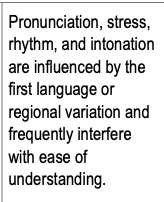 |
level 4  |
But "only sometimes interfere" with ease of understanding. What does that mean? How is that different from "frequently interfere" with ease of understanding? It's the decision of the evaluator (and that's a good thing!)
What it measures: How clear and understandable your speech is to an international listener.
-
Level 3: At this level, your pronunciation is strongly influenced by your first language. You may use sounds that don’t exist in English, making it hard for others to understand you. You might speak too quickly or too slowly, and stress and intonation may be unnatural.
- Level 4: Your accent can still be noticeable, but your pronunciation is generally clear to most international speakers. Occasional misunderstandings may happen, but you can easily correct yourself. You speak at a normal rhythm with understandable stress and tone.
Tip: To reach Level 4, focus on speaking clearly and slowing down when necessary, rather than trying to sound like a native speaker.
Show that you are in control even though your accent will be noticeable.
3. Structure (Grammar)
 |
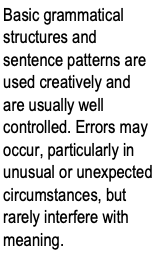 |
"Rarely interfere with meaning" again is what separates level 3 to level 4. What can we do to make sure you don't interfere with meaning?
Simple: Keep things simple...especially during your ICAO English test level 4! Pace yourself and if you can, combine your phrases with conjunctions like because, so, but...etc...
- Level 3: You can use simple sentence forms, but you often make mistakes that confuse the listener. For example, verb tenses, word order, and prepositions might be wrong.
-
Level 4: You can use basic grammar accurately and can make more complex sentences when needed. Errors still occur, but they do not usually cause misunderstanding.
Speaking of misunderstanding...
4. Vocabulary
|
Level 3 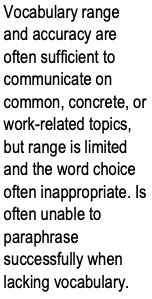 |
Level 4 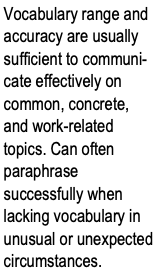 |
Again...keep things simple. It's better to show less that you are 100% sure of than more but aren't sure. That way your evaluator knows you understand the words that you are using...which is better than showing that you don't understand them.
Learn aviation terms, but also practice explaining them in simple English. For example, if you forget “altimeter,” you could say “the instrument that shows the altitude.”
5. Fluency
|
Level 3 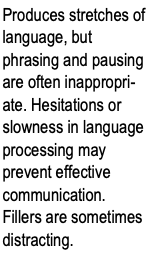 |
Level 4 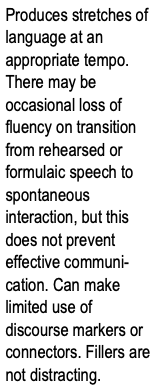 |
What it measures: How smoothly you speak without too many pauses or hesitation.
- Level 3: Speech is often slow, with many pauses and corrections. You may translate directly from your native language, which interrupts your flow.
- Level 4: You can speak at a normal speed with some hesitation only when thinking about complex ideas. You can keep the conversation going and use natural expressions.
Tip: Practice talking about aviation topics without notes. Recording yourself and listening again can help you notice where you pause or repeat words.
Feel free to contact me below and we can work on this together. You get a free consultation and we can include working on your fluency once we assess it.
6. Comprehension
|
Level 3 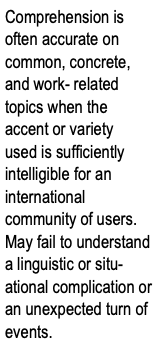 |
Level 4  |
What it measures: How well you understand spoken English, including different accents and rates of speech.
- Level 3: You understand simple, slow speech but have difficulty with faster or accented English. You may need repetition often.
- Level 4: You understand most everyday and aviation-related communication, even when spoken quickly or in an unfamiliar accent. You can ask for clarification politely if needed.
Tip: Listen to real ATC recordings, aviation podcasts, and pilot videos to get used to different accents and speeds.
7. Interactions
|
Level 3 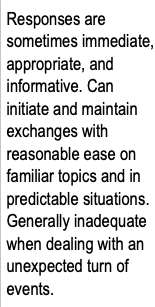 |
Level 4 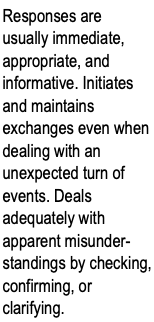 |
What it measures: How effectively you communicate and manage conversations.
- Level 3: You can respond to direct questions, but you struggle when the situation changes or when unexpected communication is needed.
- Level 4: You can handle normal and some unexpected situations. You can ask for clarification, confirm understanding, and respond appropriately.
Tip: Practice real communication scenarios with a partner — for example, reporting an emergency, clarifying instructions, or describing an equipment problem.
8. What Level 4 Means in Practice
Reaching Level 4 means you can operate safely in international environments using English. You can manage both standard radio phraseology and plain English when needed. You don’t have to be perfect, but you must be clear, understandable, and able to communicate effectively even when things don’t go as planned.
By contrast, Level 3 means your English is still too limited (or rather that you are unable to move forward because of your opinion on your English.)
You don't have to be a native speaker - you just need to know your limits and work with them!
watch me talk about it!
Check out my video on the ONE thin you definitely need to pass any ICAO level 4 exam.
Conclusion
The ICAO English assessment is not only about knowing aviation words — it tests how well you can communicate clearly, confidently, and safely in real situations. Understanding the six parts of the test — pronunciation, structure, vocabulary, fluency, comprehension, and interactions — helps you focus your study.
As a non-native speaker, your goal should always be Level 4 or higher. Click here to find out more about the level 4 ICAO requirements.
Contact me below and we can get you practicing right away for your ICAO English test level 4!
If you think you are ready you can take the ICAO English test level 4 by clicking on this link. Good luck!